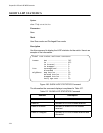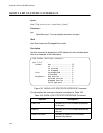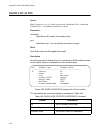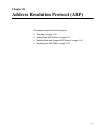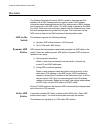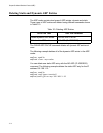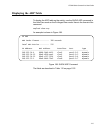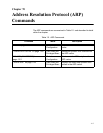
Chapter 69: Address Resolution Protocol (ARP)
1112
Overview
The Address Resolution Protocol (ARP) is used to associate an IPv4
address with a MAC address used by network nodes. ARP gathers
information about mapping between an IPv4 address and a MAC address
and stores them in the ARP cache. The ARP cache is located in the RAM
of a node. When the node receives a packet from the Network layer, then
the node encapsulates the packet into a frame. The node looks up the
ARP cache to find out the MAC address of the destination node.
ARP on the
Switch
The software supports the following settings:
Dynamic ARP entries timeout in 300 seconds
Up to 1024 static ARP entries
Dynamic ARP
Entries
ARP entries that are gathered dynamically populate the ARP table in the
cache. These are called dynamic ARP entries. Dynamic ARP entries are
updated in two ways:
During regular operations
When a node receives frames from the media, it records the
source IP and MAC addresses.
Using ARP broadcast requests
When a node creates a frame and does not find an entry of the
destination IPv4 address in the ARP cache, ARP broadcasts a
request, including the IP address of the destination host, to all the
devices on the LAN. Only the node assigned to the IP address
replies to the sender. Based on the reply, the original node makes
an ARP entry into the ARP table in the ARP cache.
On the AT-9000 switches, the dynamic ARP entries are time-stamped and
set to time out in 300 seconds.
Static ARP
Entries
A manually entered ARP entry is called a static ARP entry. Static ARP
entries never expire. You must remove them manually as needed.
The software can support up to 1024 static ARP entries.



